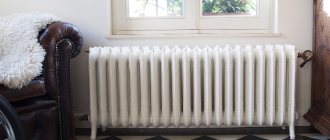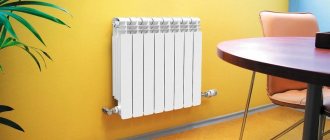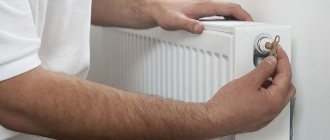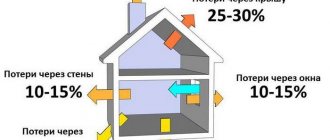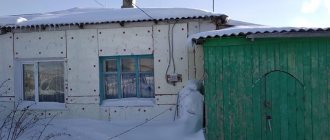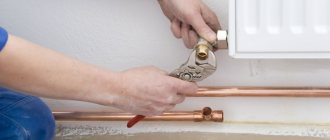Cold batteries in winter are an emergency that requires an immediate solution. To fix serious problems, you should hire specialists, but some problems can be dealt with on your own. Even if the owner of an apartment or house does not intend to repair the heating on his own, it will not hurt him to know about the signs and causes of malfunctions.
Signs and causes of poor heating performance
| Characteristic signs | Possible reasons |
| The riser is cold | Technical faults outside the apartment |
| The riser is hot, the batteries are cold | Valves are closed, heating system is clogged |
| Cold bottom of radiator | Valves are not open enough, radiators are clogged, low coolant pressure in pipes |
| Cold top of batteries | Airlock |
| The last radiator in the system is cold | System not adjusted, insufficient pressure |
| The part of the radiator farthest from the connection pipes is cold | Insufficient pressure, clogged battery, air lock |
An analysis of the events preceding their occurrence will help identify the causes of malfunctions.
| Work carried out, operating features | Possible faults |
| Replacement of heating devices, pipes | Air lock due to air entering the system or changes in pipe slopes. Clogged pipes and radiators. Reduced flow areas due to errors during system assembly |
| The heating system works without maintenance for many years | Scale has formed, the heat transfer of the batteries has deteriorated, and parts of the shut-off valves have become “stuck” |
| Start of the heating season | The boiler room did not reach its design capacity, employees of the relevant services forgot to open the valves, and air pockets formed when the system was filling. |
| Neighbors were doing renovations | Reduced pressure in the system due to unprofessional actions of neighbors |
First of all, if the heating is poor, interview the residents of the house. If they have the same problem, it means that the boiler room is not working well or the valves in the basement of the house are closed. In these cases, you should jointly contact the management company. If only one apartment is cold, check that the valves are open and there are no air pockets. Call a specialist through the dispatcher of the organization serving the house.
Working with structures
If the appeal does not help, you should find out who blocked the riser with representatives of the Housing Office. To do this, you need to contact the Housing Office, the structure will allocate a working team of several people - you cannot do the rounds yourself.
The response of the Housing Office must be demonstrated within one work shift if the application was made on a working day. During the shift, workers will go around the apartments of the building to check the supply of coolant in the heating network.
If all neighbors allowed workers to check, identifying the violator will not be difficult. First, it is enough to ask to resume the supply and start the riser in the presence of housing office workers.
If requests do not help or one of the owners does not allow workers, the identification of the culprit continues based on information from possible witnesses and the territory in which the supply is blocked.
In case of prolonged violation, a statement is filed against the culprit in court stating that he is violating the rules of use and the rights of residents to common property. Before submitting an application, it is advisable to call employees of the housing office or management company to fully check the heating system in the house and provide a written report on its serviceability.
In other words, the plaintiff must have all the documents confirming that the heat supply stopped precisely because of the illegal shutdown.
If the trial is successful and the culprit fails to comply with all the requirements of the court decision, the neighbor may be held criminally liable in accordance with Article 315 of the Criminal Code of the Russian Federation “On failure to comply with a court verdict, court decision or other judicial act.”
Basic malfunctions of heating systems and their elimination
Air jams
Air pockets occur in radiators and pipes and interfere with the normal circulation of water in the heating system. They appear for various reasons:
- violation of the technology for filling the system with water after the summer period;
- non-compliance with water deaeration regime;
- performing repairs with disassembling pipelines;
- failure to observe slopes when installing the heating system;
- air leakage through leaky joints.
To remove air from the system, use a Mayevsky valve installed on the radiator. You should open it, wait until the air comes out, the hissing stops, and the water begins to pour out calmly without bubbles. After this, the valve is closed. Don't forget to provide a container or towel to drain the water.
Old cast iron batteries do not have Mayevsky taps. The air is released without completely unscrewing the plugs at the ends of the radiators. It is better to entrust this operation to plumbers - if you unscrew the plug completely, you can flood the apartment.
Quite often in residential apartment buildings during the heating season you can encounter the following problem: the riser is hot, but the radiators are cold. This applies to both new buildings and old houses. Residents in most cases do not know how to cope with such a situation. That is why their attempts to repair the heating system on their own do not lead to the desired result. In this matter, you definitely need help or advice from a specialist. After all, only a person who has the necessary knowledge and experience can solve the problem of why the pipes are hot and the radiators are cold.
Radiators and how to avoid a situation where there is cold return in the apartment heating
For an autonomous heating system, it is necessary to choose the right batteries. For example, one section of a radiator heats 1 square meter of area. And depending on the area of the room, you can calculate how many sections there should be in the radiator. For uniform heat, you need to take into account the nuances. In a corner room or balcony, you need to add a couple of sections to the radiator. You also need to take into account that various decorative panels used to cover radiators reduce heat transfer; installation of multi-profile windows retains heat. Also, insulated walls and floors will keep the apartment warm. Installing autonomous heating is a serious process that requires experience and knowledge. There are cases when individual heating is installed in one room - cold radiators, and in others it is constantly warm, or the input to the radiator is hot and the output is cold. This is because mistakes were made during installation. It is better to carry out independent work at the final moment, when all the pipes and batteries are connected. But it is better to entrust the installation of the boiler, equipment, risers and gas supply to specialists, then there will be no questions about why the floor of the battery is hot and the floor is cold. Once the system is installed, it is usually checked by filling it with hot water. Sometimes there are water leaks, mainly at the joints. The leak must be repaired and the pipes must be re-soldered. It is from improperly soldered pipes that hot water can flow poorly into the radiators, and after draining the water, the radiators in the apartment remain cold.
Why the batteries are cold may be due to various reasons, but heating the premises can be done using old-fashioned methods, which, by the way, work well in the modern world. If the battery is half cold, what should I do? For example, using a regular fan, you can disperse heat from the battery throughout the apartment. You just need to install it near the radiator, pointing the blades at it, and turn it on. Behind the radiator near the wall, there is always a space where you can stick reflective foil or penofol. The distance between the battery and the reflector must be at least two centimeters to allow air to circulate. Otherwise, there will be the opposite effect. But with all these methods, the best would be to be careful with the heating system installed in apartments. These methods can be used if cold air comes from the radiators in the Khrushchev building. And if there is a leak in the battery, it can be repaired by cold welding. This system has already been worked out and installed, and proper use of the heating system, regular flushing of pipes and radiators, insulation of windows and floors will help achieve long-awaited warmth in the apartment. And installing individual heating will create additional comfort.
The most important thing is the weather in the house! A warm microclimate ensures the health and good nature of household members. To prevent them from deteriorating, it is very important that the radiators in the house heat perfectly. That is why, as soon as slight frosts occur, we look forward to the heating season. But it often happens that the house is neglected, but there is still no heat. Why cold batteries? Why does cold water flow from the battery? Who is to blame and what to do? The most important thing is not to panic. Before you complain to the management company, you can find a sample complaint to the management company about cold batteries on our website, try to understand the reasons, perhaps you can eliminate them yourself.
Experts explain why the batteries are cold and the riser is hot
You can't warm your hands on cold radiators.
There can be many reasons why the coolant supply pipe is hot and the radiator is cold. For general development, specialists name only the main ones:
- the central valve on the heat supply line is closed or the return line is closed;
- insufficient coolant flow;
- airing of the system or a specific riser, radiator;
- the heating system is not balanced;
- contamination in the heating circuit;
- reducing the cross-section of the coolant supply pipe.
If the riser in the apartment is warm and the radiator is cold, you need to contact the organization responsible for the heat supply of the house. Its specialists are obliged to fix any malfunction free of charge and within 24 hours.
However, the following actions by the residents of the house will help the technicians who come to the call to quickly eliminate the malfunction of the heating circuit:
- Is it necessary to install a hot pipe and a cold radiator in only one apartment or does this problem affect the entire riser. Perhaps the heating wiring of the entire entrance is faulty;
- it doesn’t hurt to go around all the entrances and see if the heating elements are hot there;
- you can go down to the basement and inspect the pipes for breakdowns. Even a drip leak leads to a drop in pressure in the system. This adversely affects her work.
All information received should be passed on to specialists. However, there are situations when the organization involved in heating the house refuses to repair the wiring. In this case, residents must contact regulatory authorities with a complaint about poor quality services. Also read: “Where should I go if the batteries don’t heat up?”
Which antifreeze should you choose for your home heating system so as not to be poisoned later if it is mixed into the hot water circuit?
Everything you need to know about filling your heating system with antifreeze can be found here.
Device for cleaning the circuit.
If the batteries do not heat up the riser. If the riser is cold, the battery is cold - this is a sure sign that the main line through which the coolant flows is blocked. To confirm this, you need to walk through the neighboring apartments. They should warm up well. In this case, only a plumber, who will have drawings of the heating wiring of the house, can fix the breakdown.
Possible problems with heating systems
The cold weather is coming and you want the house to be warm and cozy, and for this the heating system must work properly.
But sometimes it causes troubles due to various problems, and many questions arise related to its operation, for example, why the radiators crackle, why the radiator does not warm up completely.
Before considering possible malfunctions of the heating system, let’s remember what types of radiators exist:
- Steel panel radiators, called convectors.
- Cast iron radiators.
- Steel tubular radiators.
- Aluminum radiators, which, in turn, are divided into cast and extruded.
- Bimetallic radiators.
When you choose the types of heating batteries, photos can be found on specialized Internet sites, where there is information about their characteristics.
Currently, many people are installing a protective screen for radiators. There are two types of these screens:
- a full-fledged protective casing that covers the radiator from all sides;
- Radiator covers that serve as decoration and cover only the front part of the radiator.
Protective screens for heating radiators are divided according to the type of material made. They can be divided into metal, wood and plastic.
The disadvantage of protective screens is that they obstruct the flow of thermal air and lead to heat loss.
Possible malfunctions in heating systems and their elimination
During the operation of heating systems, various problems may occur, the causes of which may be the following:
- Air pockets that occur in any section of the pipeline. This may be caused by malfunctions of the air collectors. It can be eliminated by bleeding air from the system, and you should also check the correct operation of all radiators so that there are no air bubbles.
- Incomplete opening of shut-off valves on the supply or return lines. In order for the heating system to work normally, it is necessary to completely open the shut-off valves.
- The risers or wiring to the heating equipment may be clogged. The clogged area is disassembled, cleaned and put back in place; in case of severe clog, it is removed from the system.
- Boiling of water in the heating system. To eliminate this malfunction, an expansion tank is installed in the return or supply line.
What to do if the radiators in the apartment are cold and the riser is hot?
Regardless of whether the cold heating equipment is only in the riser or in the entire entrance, and possibly throughout the house, you must seek help from qualified specialists. In the case of an apartment building, this is a plumber of the company that is responsible for the heating supply of the house.
Cold batteries with a hot riser may be due to a clogged system or the formation of an air lock in it. An important factor is the pressure in the wiring. In some cases, the problem of low coolant flow is relevant. It is possible to independently find out the reason for the low efficiency of heating elements. But only a true professional in his field will clearly answer any questions that arise and competently fix the breakdown. This video will help you to make your radiators heat better:
Heating is a complex system that has its own design features. Owners often ask the question: why is the radiator hot on top and cold on the bottom? This is a serious problem, it causes a lot of inconvenience and requires careful analysis.
Why is this situation dangerous?
- The actual efficiency of the radiator decreases.
- The room temperature decreases.
- It becomes uncomfortable to be in the room.
- Adjustment and use of additional fittings cannot cope with this situation.
Installed radiator in a wooden house
But what is the reason for such a problem and is there a worthy solution? This issue should be looked into in more detail and some advice given to the owners.
Important!
Please note that a slight temperature difference between the lower and upper parts is not a deviation. You should be concerned when the heating decreases significantly; it negatively affects the efficiency of the radiator.
Why is the bottom of the heating radiator cold? It should be said that in almost all battery models the temperature in the lower part is slightly lower than at the inlet. This is due to the high level of heat transfer; the water has time to cool significantly before leaving the device. A temperature difference arises, which somewhat frightens the owners. So, if there are small differences, there is no need to worry, this is a completely normal situation.
But if the difference increases significantly, the lower part is a little warm or almost cold, then this fact indicates serious problems. The efficiency of the system is significantly reduced, the battery is unable to provide sufficient heat. This negatively affects the temperature in the room, so immediate action must be taken.
The most common reasons:
- During installation, the supply and return pipes were mixed up.
- Low fluid circulation rate.
The first case is quite common; similar situations can arise when connecting independently or using the services of unqualified craftsmen. Any violations of the circuit lead to the impossibility of further full operation of the radiator.
In the second case, the water flow rate inside the radiator is quite low, which negatively affects its operation. The liquid has time to cool completely before leaving the battery. A slowdown in the flow rate can be caused by many reasons, each of which requires prompt elimination.
Application Form
An appeal to the court is filed depending on how the management of the apartment building is carried out.
What to do if you have an HOA:
- After the meeting, the chairman draws up an act in which all neighbors on the council sign;
- The chairman draws up a statement indicating the full name of the violator, his residence/registration address (if the two addresses do not match) and the type of violation;
- The chairman supplements the package of documents with an act of inspection of the heat supply system by housing and communal services workers;
- To certify the position of the riser valve, you can apply a seal and draw up an additional report about it.
What to do if there is no HOA:
- A request is made for representation in court to the employees of the housing office that services the house;
- The housing office draws up an application to the court and attaches all documents available on the case.
If there is no proactive representative in the house, you have the opportunity to contact the local police officer. He is obliged to notify the executive authorities of violations, then the executive authorities, housing inspection or municipal housing control authorities will draw up a statement to the court.
Incorrect connection
Incorrect pipe connection is one of the possible reasons for reduced radiator efficiency. This is a gross mistake; experienced craftsmen do not make such mistakes; most often they arise after the work is performed by amateurs.
Incorrect radiator installation
The return pipe is connected to the upper pipe, the supply pipe is connected to the lower pipe. As a result, a range of related problems arise:
- The circulation of water and the full operation of the heating system are completely disrupted.
- The efficiency of the radiator and its heat transfer decrease; water is unable to completely fill all sections.
- The process of draining liquid from the battery is disrupted.
Other reasons
A common reason is a reduced coolant flow rate. This problem can occur in several cases:
- Narrowed pipe section.
- The coolant moves at low speed directly in the heating system.
Low coolant movement speed occurs when the pump power is insufficient to circulate the liquid within the system. Water cannot overcome the radiator with sufficient speed and go into the outlet. A similar problem often arises in gravity systems; they completely lack additional equipment.
The simplest gravitational scheme
Narrowing of pipes occurs in several cases:
- Incorrect soldering of polypropylene pipes.
- Problems arise when installing an adjustment valve with a narrowed cross-section.
- Presence of deposits in the pipe, reducing throughput.
Another possible reason is a fairly low room temperature. The coolant in the radiator cools faster and delivers the maximum amount of energy. It is quite natural that the bottom of the battery can be much colder.
Important!
It is necessary to conduct a consistent check of the system, evaluate the condition of all elements and find the cause of the problem. In the future, it will be necessary to eliminate it to ensure complete water circulation in the radiator.
Sounds from heating devices
If you hear a howl in the middle of the night, then most likely the system has leaked. A cloud of steam and a characteristic whistle will immediately indicate a gust or a failed valve. In some cases, it is enough to close the tap to bring the heating system into working condition.
If no obvious causes are found, and the howling is accompanied by a crackling sound, it is necessary to check the pressure. Perhaps the flying scale blocked the free flow of the coolant, which caused increased pressure - it is urgent to stop the boiler, drain the water and look for the problem.
It happens that the batteries start to “shoot” - this is another reason to be wary. Such noise is typical for bimetallic batteries when the pressure in the system does not coincide with the calculated one.
When purchasing heating appliances, you need to take into account the operating parameters of the boiler and select the appropriate radiator. Otherwise, the problem may result in a rupture of the heating device due to water hammer, which is completely inappropriate in the winter cold.
Heated water is not able to compress; it needs to move freely along the contour. Banal deposits in pipes can provoke an increase in pressure and rupture of pipes due to water hammer.
Another reason is an air lock, which can be eliminated through the Mayevsky drain valves located at the ends of the batteries. The procedure is simple, and anyone can handle it.
Elimination
If you notice that the bottom is significantly colder than the top, then urgent action is required. It is necessary to follow the following algorithm to find the cause:
- Checking the correct connection.
- Inspect the radiator, bleed and clean it.
- Assess the condition of the control valves.
- Check the pipes.
- Determine the type of heating system, install or replace the circulation pump.
The first step is to check the correct connection. To do this, it is necessary to estimate the temperature of the lower pipe. If the return and supply were connected incorrectly, it will be hot. You will need to reconnect and build the circuit correctly. When connected correctly, this element remains slightly warm.
Often the cause is an air lock in the battery, which does not allow the coolant to spread throughout the radiator. The design must include a Mayevsky valve or bleeder for air removal. It is necessary to shut off the supply, open the drain and remove all air and batteries. After the tap is turned off, the heating valves are turned. In some cases, this procedure turns out to be effective.
If an adjustment valve is installed in the system, then there is a high probability that the problem is there. It is necessary to dismantle this element and carry out an inspection. If the section is narrowed, you will need to expand it using specialized tools. But it is better to purchase a higher quality part and reinstall the tap into the system.
I will describe my problem in detail, since the mechanics of the local management company shrug their shoulders, and I myself cannot understand what the reason is ((And it all started like this: We have 2 risers in our apartment - one in the hall, the other in the kitchen, which is connected through crosspieces in the kitchen and children's room. Last year everything was changed to propylene from the basement, we have a second floor, there is a bank below us, there are 2 more floors above us, the neighbor in the 5th compartment has his own apartment and is heated independently. Riser systems are based on the "supply-return" system , last year they worked well, and this year, as soon as the heating was turned on, everything was fine. It worked for a month without interruptions, the return and supply were hot. 2 weeks ago the return cooled down, and then the pipes completely cooled down. They gave a request, a mechanic came, He said that we need to wait for the cold weather, that maybe the boiler room is not adding pressure or whatever. I go upstairs to my neighbor - there is circulation above me, both risers are hot, return and supply. I go up to my neighbor on the 4th floor - everything is there, both risers heat perfectly. I am perplexed - why am I having a problem on the second floor? I think maybe something is clogged? But the pipes are new, sawn everywhere - what could be there? I don't understand. A mechanic comes, lowers something in the basement, and the risers begin to heat up. They heat up normally, cool down after 15 minutes. There is no airing, I constantly bleed through Mayevsky - only water comes out, no air. Yesterday I shut off the American 3/4ths in front of the battery, removed it, washed it (Sandital radiators, aluminum with anti-corrosion coating), put it in place (first I drained the water from the riser - both from the return and from the hot one in case there was something there got into trouble), filled it with water - the supply and the upper part of the battery began to heat up. I turn off the supply, release the return through the battery - it starts to heat up, I stop draining - it cools down. Thus, the upper half of the battery worked until 23:00, then it began to cool down. This morning the mechanic came again, threw up his hands and went up to the neighbor: everything was fine with him. As a matter of form, he went down to the basement and pumped something there - it began to circulate, then died out again. In general, help me solve the puzzle! I can't figure out what's wrong:
- Everything worked for 1.5 months, there was circulation. Return and feed worked.
- Two weeks ago everything disappeared, but only here, on the second floor. The neighbors above have everything.
- There is no blockage or clogging in the radiators, and no in the risers either.
- There is no circulation. What the heck? We didn’t change anything structurally, the circuit worked the same way last year, everything was warm!
- The housing department said that some residents also have this problem, which means I’m not alone. But they may just be airy.
- There is no airiness, everything is lowered 100 times through Mayevsky and removing the batteries.
Ways to troubleshoot heating system problems
The method for solving a heating system problem depends on the type of breakdown. Let's consider each option in more detail.
Clearing the blockage
- First of all, you need to determine the location of the blockage. Measuring the temperature most likely will not give the desired result, so it is better to use the acoustic method and start listening to the system.
- Then you can move on to cleaning or flushing the pipes. Before doing this, you must inspect the system and make sure it is tight.
- The hydraulic method involves ensuring a constant flow of water inside clogged pipes. The higher the water flow rate, the larger the blockage that can be removed. In some situations, different pumps are used. But this method is not suitable for areas with initially low water speed, since clog particles will still settle in the pipeline.
- Cleaning is carried out when the hydraulic method does not give a positive result. In this case, the required section of the system is turned off and water is released from it. Next, this section is disconnected from the pipes, and the blockage is broken through using wire. After this, a brush is fixed to the end of the wire, which removes the accumulated particles.
Removing air lock
- To find the problem area, in this case tapping with a hammer is used. In the area with an air lock, the sound is amplified.
- If the problem is a temporary decrease in the temperature of the heating devices, then air collectors are installed in areas with formed air pockets.
- If a plug has formed in places where the pipe is kinked, then air bleed valves are installed in problem areas.
Experts explain why the batteries are cold and the riser is hot
You can't warm your hands on cold radiators.
There can be many reasons why the coolant supply pipe is hot and the radiator is cold. For general development, specialists name only the main ones:
- the central valve on the heat supply line is closed or the return line is closed;
- insufficient coolant flow;
- airing of the system or a specific riser, radiator;
- the heating system is not balanced;
- contamination in the heating circuit;
- reducing the cross-section of the coolant supply pipe.
If the riser in the apartment is warm and the radiator is cold, you need to contact the organization responsible for the heat supply of the house. Its specialists are obliged to fix any malfunction free of charge and within 24 hours.
However, the following actions by the residents of the house will help the technicians who come to the call to quickly eliminate the malfunction of the heating circuit:
- Is it necessary to install a hot pipe and a cold radiator in only one apartment or does this problem affect the entire riser. Perhaps the heating wiring of the entire entrance is faulty;
- it doesn’t hurt to go around all the entrances and see if the heating elements are hot there;
- you can go down to the basement and inspect the pipes for breakdowns. Even a dripping leak leads to a fall. This adversely affects her work.
Device for cleaning the circuit.
If the batteries do not heat up the riser
. If the riser is cold, the battery is cold - this is a sure sign that the main line through which the coolant flows is blocked. To confirm this, you need to walk through the neighboring apartments. They should warm up well. In this case, only a plumber, who will have drawings of the heating wiring of the house, can fix the breakdown.
The following state of affairs, when the pipe is hot and the battery is cold, indicates a blockage in the system or the presence of an air lock. It prevents the penetration of coolant into the heating element. As a result, the latter does not warm up. Blockages can only be eliminated if you completely disassemble the radiator and force air through it under pressure. This can only be done by a specialist who has the necessary tools and equipment.
If the radiators in the entire entrance do not heat
. When the heating radiator is cold and the riser is hot, you need to pay attention to the pressure in the circuit. If the pressure is insufficient, the coolant cannot pass through all the radiators in the circuit. As a result, the batteries lower their temperature as they move away from the heat-carrying main. Residents of the house cannot increase the pressure in the system on their own, and therefore it is recommended to seek help from professionals. More specifically, call the organization that is responsible for the heat supply of the building.
The supply and return may be reversed.
Residents of a new house, when starting up the heating system for the first time, may observe the following situation: the battery is cold and the return is hot. Here it is appropriate to assume that errors were made when installing the heating elements. In this case, the pipes supplying coolant and the return circuit are swapped. If we are talking about an individual heating circuit, then it is worth taking a closer look at the circulation pump. It may not be installed correctly.
When asked why there is cold return in the radiators, experts clearly point to an incorrectly designed heating system. In some cases, it is appropriate to talk about low coolant flow.
No circulation, heating failure - why
Failure in the heating system, deficiencies, imperfections, all lead to cold radiators.
If there is no coolant circulation, then the reason needs to be determined. Most often, the answer to why the heating does not work is on the surface, obvious. Let's look in order at the main causes of heating malfunctions, why water does not circulate through the pipes, and what needs to be done first.
Let's start with the simplest and most obvious reasons.
It's clogged and clogged.
Every heating system must have a coarse filter. A very small device with a fine mesh and a sump (installed downwards! or at least to the side) saves equipment, pumps, and the boiler from coolant contamination that will be present in any system. Wood shavings, broken threads, rust, water sediment…. everything is retained by the mesh in the filter.
The sedimentation tank must be periodically untwisted and the mesh cleaned.
If the circulation in the heating system of a private house is disrupted, then the first thing you need to do is check the filter, which should be installed on the return line in front of the boiler.
Air in the system, airing
Airing can occur in any closed piping system where air removal measures have not been taken. Air is always present in the coolant, including in a dissolved state, is released during pressure changes, and accumulates at the highest points. Including in the boiler.
Automatic air vents are installed at characteristic, highest points of the system, as well as on collectors and special separators - the normal circuit is equipped with a special air catching device in which air bubbles are released from the coolant.
In addition, Mayevsky valves (manual air vents) should be on each radiator, and also possibly in other elevated places.
Checking the air supply, bleeding the air, installing air vents are common actions if circulation stops and the batteries are cold.
The circulation pump does not work
In private homes, the reason why the heating system stops working is a breakdown of the electrical equipment that controlled the movement of the coolant through the pipes.
If the heating suddenly stops working, then you need to check the functionality of the circulation pump near the solid fuel boiler or the pump in the automated boiler. In addition, the same unit can be installed in each circuit, which must work properly.
Bad polypropylene pipes
Often the consumer (customer) believes that polypropylene pipes are absolutely reliable and cannot cause heating problems or cold radiators.
But polypropylene is much more insidious than old steel or metal-plastic pipelines. Each place of soldering (welding) is a potential increased resistance in the system or a cause of cessation of circulation (weakened movement of water through the batteries), due to deposits of material inside.
It is impossible to control the quality of connections from the outside; all that remains is to cut out pieces, resolder, and remake polypropylene pipes.
Poor performance of a polypropylene system is a real problem for the home installer. Good professionals don’t take on this material at all.
Bad project
It is not uncommon for poor circulation to occur where there is poor design. Typically, the batteries are not connected correctly, according to some sequential circuit, where the last battery in the circuit receives much less coolant.
Another bad design is single-pipe circuits, where it is also difficult to establish the necessary coolant circulation through each battery.
If the radiators do not heat up evenly, or there is poor coolant circulation on individual heating devices, first of all you need to consider how the connection corresponds to the classic circuits - shoulder, associated, radial. It is necessary to bring home heating to normal design standards, and then expect good circulation and uniform heating of the radiators.
Small diameter, overgrown pipes
Old steel pipes become overgrown with rust and deposits from the inside, their throughput capacity decreases significantly over time, and there is only one solution - they need to be replaced with modern ones.
But even during installation, for the sake of economy, mistakes can be made with the choice of pipeline diameter - on mains, on groups of heating devices, diameters of 16 or 20 mm can be installed. The result is noise in the pipes, excessive consumption of electricity, and insufficient coolant flow. What pipe diameters should you choose?
A complex system
A type of bad design is an incorrectly designed complex heating system consisting of many heating circuits and several boilers. Here entire circuits will not work correctly if the work of one affects the neighboring one.
As a rule, one boiler (the backup one does not count) and three circuits - boiler, radiators, heated floors with their pumps are coordinated normally, and no questions arise. But if you connect another working boiler plus a circuit (for example, heating a garage and greenhouse), then the system will become complex. It is difficult to say how the coolant will circulate in it without equalizing the pressures at the connection points.
In complex systems, a competent design is important, installing a hydraulic arrow or an equal pressure ring; more information about the hydraulic separator can be found here
No balancing
Many home heating schemes involve balancing; balancing and control valves are installed in them. For example, between floors, between shoulders, and for each radiator. The taps cover the direction with less hydraulic resistance; accordingly, more coolant will flow to other points.
What to do if the radiators in the apartment are cold and the riser is hot?
Regardless of whether the cold heating equipment is only in the riser or in the entire entrance, and possibly throughout the house, you must seek help from qualified specialists. In the case of an apartment building, this is a plumber of the company that is responsible for the heating supply of the house.
Cold batteries with a hot riser may be due to a clogged system or the formation of an air lock in it. An important factor is the pressure in the wiring. In some cases, the problem of low coolant flow is relevant. It is possible to independently find out the reason for the low efficiency of heating elements. But only a true professional in his field will clearly answer any questions that arise and competently fix the breakdown. This video will help you to make your radiators heat better:
The legislative framework
Heating risers are defined by the Housing Code of the Russian Federation as common property in an apartment building. This means that any heat transfer communications, starting from the border of the local area and to the beginning of the private property (before the beginning of the apartment), belong to the common property of the apartment building.
In this case, the boundary of private property is considered to be the outer walls of the apartment, including the thresholds of the entrance doors. Up to the walls and thresholds, any communication will be considered common and no neighbor has the right to dispose of it at his own discretion.
According to the provisions of the Housing Code on the management of the property of an apartment building, there may be several options for disposing of common property: with an HOA and with a housing office.
If a homeowners association is organized in the house, there is a manager and/or chairman, then the decision on the management of common property should be proposed for discussion by members of the house council. Then the chairman must organize a general meeting of the owners of the premises in the house and bring up for discussion the issue of orders for the operation of the riser.
Only after all the owners unanimously decide on the issue of blocking at a general meeting, the risers can be blocked.
Ideally, the chairman should draw up an act of the meeting with the signatures of the house council members stating that the decision to block was made unanimously and no one has any objections.
If a homeowners association is not organized in the house, you must contact the housing office or management company to order the disconnection of the riser.
In order to have a legal basis for the overlap, it is also recommended to collect the signatures of the apartment owners. Since heating risers belong to common property, it is illegal to close them at the request of only one homeowner in an apartment building.
Natural shut-off of the heating riser:
- Carried out by housing and communal services workers or plumbers at home;
- Conducted with the consent (preferably written) of all homeowners in the house after a general meeting of the HOA or an appeal to the Housing Office;
- Confirmed in writing if any claims arise.
Irregular blocking of the heating riser:
- Conducted without the consent of the owners of apartments in the building;
- Performed by the owner of one of the apartments at his own discretion.
